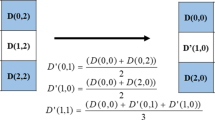Abstract
In this paper, an adaptive DE-based reversible steganographic scheme with bilinear interpolation and simplified location map is proposed. In traditional reversible difference expansion (DE) scheme, it suffers from two problems: the embeddable location is considered insufficient and the embedding payload control capability in single layer embedding is weak. For the first problem, the kernel of bilinear interpolation is applied to effectively improve the number of the embeddable location while the quality of the stego-image can be maintained at a good level. In addition, the proposed simplified location map is used for the existing adaptive embedding rule to improve the second problem where the secret data can be adaptively embedded and also the load of additional information can be reduced. The experimental results revealed that the proposed scheme presented better visual quality of the stego-image and carried larger embedding payload than some other revised DE schemes, such as Alattar’s and Lee’s schemes.







Similar content being viewed by others
References
Alattar M (2004) Reversible watermark using the difference expansion of a generalized integer transform. IEEE Trans Image Process 13(8):1147–1156
Bender W, Morimoto N, Lu A (1996) Techniques for data hiding. IBM Syst J 35:313–336
Celik MU, Sharma G, Tekalp AM, Saber E (2005) Lossless generalized-LSB data embedding. IEEE Trans Image Process 14(2):253–266
Chang CC, Hsiao JY, Chan CS (2003) Finding optimal least-significant-bit substitution in image hiding by dynamic programming strategy. Pattern Recogn 36(7):1583–1595
Fridrich J, Goljan M, Du R (2001) Invertible authentication. In: Proceedings of SPIE, Security watermarking of multimedia contents, San Jose, California: 197-208
Johnson NF, Jajodia S (1998) Exploring steganography: seeing the unseen. IEEE Compute 31(2):26–34
Kamstra L, Heijmans H (2005) Reversible data embedding into images using wavelet techniques and sorting. IEEE Trans Image Process 14(12):2082–2090
Kim HJ, Sachnev V, Shi YQ, Nam J, Choo HG (2008) A novel difference expansion transform for reversible data embedding. IEEE Trans Inform Forensic Security 3(3):456–465
Lee CC, Wu HC, Tsai CS, Chu YP (2008) Adaptive lossless steganographic scheme with centralized difference expansion. Pattern Recogn 41(6):2097–2106
Lehmann TM, Gonner C, Spitzer K (1999) Survey: interpolation methods in medical image processing. IEEE Trans Med Imag 18(11):1049–1075
Ni Z, Shi Y, Ansari N, Wei S (2006) Reversible data hiding. IEEE Trans Circuits Syst Video Technol 16(3):354–362
Tian J (2003) Reversible data embedding using a difference expansion. IEEE Trans Circuits Syst Video Technol 13(8):890–896
Tseng HW, Chang CC (2008) An extended difference expansion algorithm for reversible watermarking. Image Vis Comput 26(8):1148–1153
Author information
Authors and Affiliations
Corresponding author
Rights and permissions
About this article
Cite this article
Liu, YC., Wu, HC. & Yu, SS. Adaptive DE-based reversible steganographic technique using bilinear interpolation and simplified location map. Multimed Tools Appl 52, 263–276 (2011). https://doi.org/10.1007/s11042-010-0496-0
Published:
Issue Date:
DOI: https://doi.org/10.1007/s11042-010-0496-0




